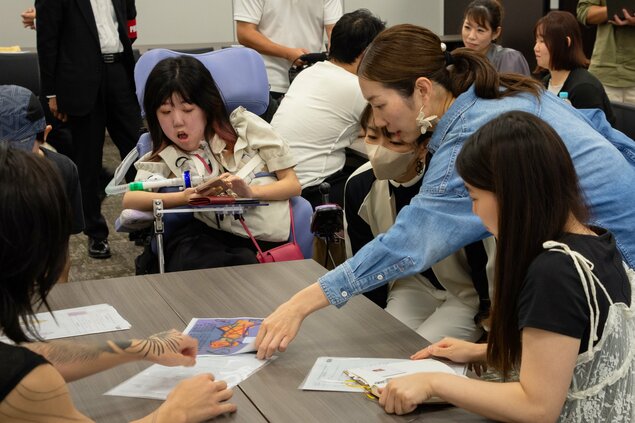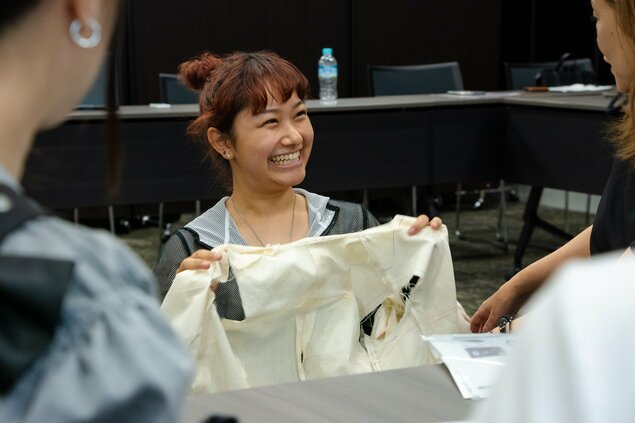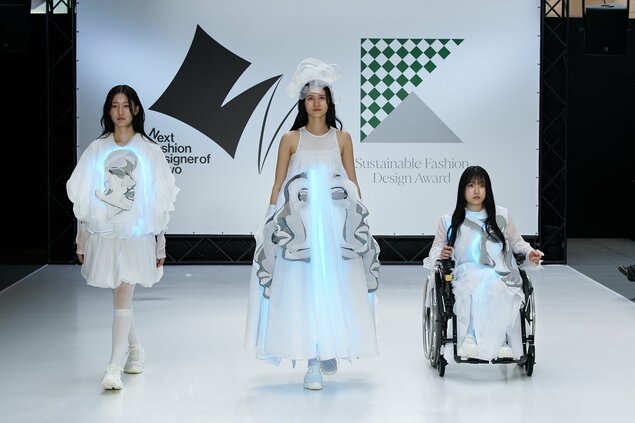Tokyo’s brightest young fashion designers fine-tuned their craft at an inclusive design workshop in Shinjuku in September, part of a contest aimed at unearthing talent to help establish the capital as a global fashion hub.
With around 2,000 entrant applications received for 2026, Tokyo’s annual awards the Next Fashion Designer of Tokyo (NFDT) and the Sustainable Fashion Design Award (SFDA) form one of the most anticipated fashion contests in Japan.
At the workshop in Shinjuku, designers among the 14 who made it through the first round of NFDT’s Inclusive Design category, were given the opportunity to improve their designs going into the latter stages of the competition, due to conclude in March next year.
The Inclusive Design Category covers clothing that can be worn by people with or without disabilities. Workshop participants, all students at design institutions in Tokyo, discussed their designs with a panel of advisors, including those with disabilities.

Students talk with advisors during the Next Fashion Designer of Tokyo inclusive design workshop in Shinjuku on Sept. 24, 2025.
Daisuke Uehara, a Paralympic ice hockey silver medalist, has served as one of the award’s special advisors since its inception in 2022. Speaking ahead of the workshop, Uehara said that the Inclusive Design category is a great way to create more choices for people with disabilities.
“It used to be that the only things we could wear were t-shirts and jeans, but through the students’ designs the option to wear outfits like suits and kimono has become available. We have more choices. I think that’s a key point of inclusive design,” he said.
As well as function and form, participants must consider the mental effects of their designs on the wearer. Uehara said the students’ designs should get people excited and motivated to go out.
“What the students are doing here will lead to happier lives for people with disabilities. It will lead to connections between people, which will lead to opportunities. Fashion is very important in this regard,” he said.
During the workshop, students were separated into groups according to the disability their designs addressed.
Fuuya Inoue, a fourth-year student at Tokyo Mode Gakuen, calls his design “Inversa.” The elegant outfit features reversible tops and pants to help remove anxieties for the visually impaired when getting dressed. Textured fabrics are aimed at enhancing the wearer’s experience of the outfit.
After speaking with advisor Marina Sato, who is completely blind in one eye and has only partial sight in the other, Inoue (21) said he understood more about people’s feelings towards clothes.
“I got a sense of what people feel anxious about and what makes them feel more secure when wearing clothes,” he said. “I realized there are aspects of the design that I haven’t given enough thought to. After hearing what Marina had to say, I think it can be made even better.”
Yukino Ooishi, a student in her second year at ESMOD Tokyo, designed clothes that wheelchair users can easily change into and out of. The 24-year-old brought samples of her design to the workshop for the advisors to try on.
“There are some things that only a person with a disability can understand so I feel like I was able to gain a perspective that I don’t have,” she said.
Ooishi was, in part, inspired to join the contest by her grandfather who was paralyzed below the waist. She had always wondered what she could do to help.
“It’s a different way of designing clothes so I’m still feeling my way around and am a little nervous,” she said. “But my ideas have become clearer thanks to the workshop so I would like to give it my best during the next stage.”

Student Yukino Ooishi talks with an advisor during the Next Fashion Designer of Tokyo inclusive design workshop in Shinjuku on Sept. 24, 2025.
The students will use their experience to prepare for the second round of judging — presentations about their looks and the display of their designs on mannequins to be evaluated by expert judges. Designs have also been posted on the award’s official Instagram account, through which the public can vote by “likes” until Oct. 31.
The successful designers will then learn how to turn a design into a product they can sell, and refine their looks ahead of the final round of judging.
Next Fashion Designer of Tokyo comes to a climax with a runway fashion show before a large audience, due to be held in March. The winners of the Tokyo Governor’s Award Grand Prize in the contest’s free category and Inclusive Design category will be determined by expert judges.
The winning designers will receive one million yen in prize money and have their designs displayed at facilities around Tokyo, as well as in their home prefecture. They will also receive support in starting a business or launching a brand, and assistance in participating in exhibitions in Paris during Paris Fashion Week.
And it is hoped that they will help Tokyo take its place among the great fashion cities of Paris, Milan, New York and London.

Models pose on the catwalk during last year’s Next Fashion Designer of Tokyo and Sustainable Fashion Design Award show in March 2025. (Photo courtesy of the Tokyo Metropolitan Government, Bureau of Industrial and Labor Affairs.)
Sakura Kato, from the association mogmog engine, which runs a community for children with eating and swallowing disorders, has served as a special advisor for the award alongside Uehara since the first contest.
Kato, who has a daughter with Fukuyama congenital muscular dystrophy, leaving her bedridden and requiring assistance to change clothes, said that the award helps to broaden the scope of fashion.
“The students’ designs are for people who have been excluded or not even considered until now. By starting with these people in mind, fashion can become even more accessible for everyone, which I think is groundbreaking,” Kato said.
Win or lose, though, Kato believes that just by engaging with inclusive design the students are contributing to change for the better.
“The designs will serve as proof that many different people exist in the world, which I think will make it a much kinder place,” she said.
Kuuya Minagawa, a third-year student at Bunka Fashion College, made it all the way to the final of last year’s contest. The 23-year-old is back to try again, enjoying the sense of connection the contest brings.
“Of course, you have to take in some tough opinions, but I think what really helps is being able to build connections with people. I feel their warmth and they’ve helped me to grow as a designer,” he said.
For more information visit the official websites:
https://sfda.metro.tokyo.lg.jp/en/

![Tokyo’s next fashion designers breaking ground for inclusive future [PR] Tokyo’s next fashion designers breaking ground for inclusive future [PR]](https://www.alojapan.com/wp-content/uploads/2025/10/1760603545_img_40cdf041b7b17a97c4349086416d4f7d1750120-1170x780.jpg)
AloJapan.com